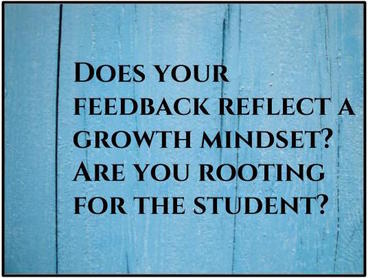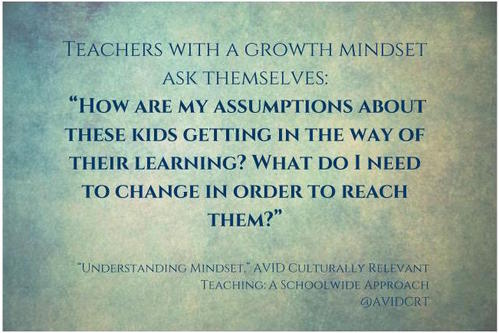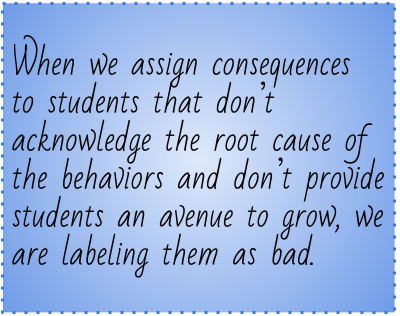The following post contains links (book images and links) to Amazon products as part of the Amazon Affiliates program.
Feedback is one of the most crucial things we will give to a student in our classroom. The feedback we give should reflect a growth mindset. We can’t expect our students to have a growth mindset unless we model having a growth mindset ourselves.
What does it mean to have a growth mindset as a teacher?
What does it mean to have a growth mindset as a teacher?
- Assume positive intent: All kids want to learn. Teachers with a growth mindset never say, “These kids can’t learn. They won’t even try.” Instead, teachers with a growth mindset always ask themselves “How are my assumptions about these kids getting in the way of their learning? What do I need to change in order to reach them?”
- Root for the student: Alice Keeler (@alicekeeler) tweeted this statement that I try to hold present in my thoughts when providing feedback. She said, “I’m always rooting for the student and will look for evidence however I can find it.”
Advertisement
The following 3 feedback suggestions are all examples of ways to “root for the student.”
1. I’m giving you these comments because I have very high expectations and I know that you can reach them.
In a study led by Geoffrey Cohen at Stanford University, researchers found that building trust through positive feedback led to better academic outcomes. In the first two studies, students wrote an essay and teachers gave their typical encouraging and critical feedback. The difference was in a note attached to the essay. The condition group received a note stating, “I’m giving you these comments because I have very high expectations and I know that you can reach them.” This type of feedback is called “wise feedback.” The control group received a placebo note stating, “I’m giving you these comments so that you’ll have feedback on your paper.” The end result? Students who received the “wise feedback” chose to revise their essays more often and improved their performance significantly, with a much greater effect on African-American students (the only minority group in the study). The key to the feedback is that it conveyed high expectations and assurance that the student could reach them.
In a study led by Geoffrey Cohen at Stanford University, researchers found that building trust through positive feedback led to better academic outcomes. In the first two studies, students wrote an essay and teachers gave their typical encouraging and critical feedback. The difference was in a note attached to the essay. The condition group received a note stating, “I’m giving you these comments because I have very high expectations and I know that you can reach them.” This type of feedback is called “wise feedback.” The control group received a placebo note stating, “I’m giving you these comments so that you’ll have feedback on your paper.” The end result? Students who received the “wise feedback” chose to revise their essays more often and improved their performance significantly, with a much greater effect on African-American students (the only minority group in the study). The key to the feedback is that it conveyed high expectations and assurance that the student could reach them.
|
This type of feedback helps to combat stereotype threat for students. Stereotype threat is “any situation in which a negative stereotype about an individual’s social identity could potentially be confirmed.” Psychologist Claude M. Steele has researched the effects of stereotype threat on individuals. In his book, Whistling Vivaldi: How Stereotypes Affect Us and What We Can Do, he explains that when individuals are in situations where their stereotypes might be confirmed, they can experience a “self-fulfilling fear” that impedes their performance.
In Cohen’s review of the research on feedback, he explained that practices “such as overpraising mediocre work or withholding criticism” negatively impact students because it “reinforce[s] minority students’ perceptions that they are being viewed stereotypically.” Combat stereotype threat in your classroom by building a culture of growth mindset through positive feedback. |
In all the feedback that you provide, make sure that it is honest, communicates high expectations, and implies a belief that students can improve and meet the expectations. Try these simple phrases the next time you give feedback:
- I’m giving you these comments because I have very high expectations and I know that you can reach them.
- Because I believe in your ability to improve and grow, I’d like to see you try these revisions/different strategies.
|
2. Now that you can _____, you are ready for _____.
Patty McGee, author of Feedback that Moves Writers Forward, said on Twitter (@pmgmcgee), “Leave the word ‘but’ out of feedback and use ‘because…. You are ready for….’ EX: BC you came up with an idea you are ready to plan.” In this feedback style, you give specific praise (growth mindset win!) and demonstrate that you have high expectations for students by giving them a specific skill to advance on. This style affirms students while challenging them to improve. |
3. A way to “level up” your work would be to _____.
This feedback style is similar to #2. The twist is that you “gamify” your language and challenge the students to improve like they are challenged in video games. This type of language can help students avoid personalization of the feedback and think of it as the natural next step. You also then reinforce the idea that learning doesn’t stop at the feedback.
This feedback style is similar to #2. The twist is that you “gamify” your language and challenge the students to improve like they are challenged in video games. This type of language can help students avoid personalization of the feedback and think of it as the natural next step. You also then reinforce the idea that learning doesn’t stop at the feedback.
One last thing…
These feedback styles all suggest an opportunity to revise or redo the work. A growth mindset culture thrives on the idea that learning is an ongoing process with no set-in-stone learning dates. These feedback styles on their own cannot combat a rigid classroom culture that deemphasizes growth.
These feedback styles all suggest an opportunity to revise or redo the work. A growth mindset culture thrives on the idea that learning is an ongoing process with no set-in-stone learning dates. These feedback styles on their own cannot combat a rigid classroom culture that deemphasizes growth.






 RSS Feed
RSS Feed
